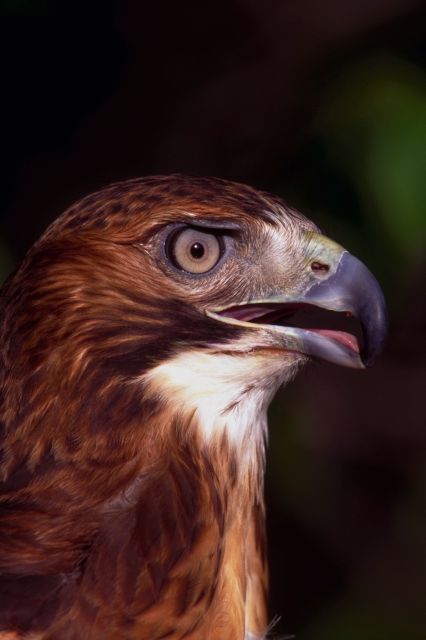|
Here I will try to explain the physics of a predatory bird using the pictures from the Galery of Tripod. One of the niest
pictures I have found there is the head of a predatory bird as given in the following. However, Tripod does not give the name
of the animals in the pictures. So I have to use my books and to guess the specific kind.
It seems to me that the following picture is the head of a Spotted Eagle (Aquila clanga). Anyway, my physical explanations
will be good for many kinds of this predatory bird family. Here is the picure:

Physical Explanation to the colors on the head of the Spotted Eagle:
(Note: The colors in the picture
may depend on the parameters in the user comuter. I give my explanation acording to the colors in my computer).
The
Spotted Eagle belongs to the family of Predator Birds. Predator birds are usualy inserting their beak and part of their head
into the body of the prey. They usually tear the body of the pray with a lot of force. The crooked edge of the beak helps
to achieve this goal. Howevere, when the beak tears an hard body it might be in big tension stresses. One could think of a
simple solution such as creating an heavy beak with hard matterials. Howevere, such solution leads to heavy beak. Heavy beak
creates big physical moment on the neck of this bird. The solution of Nature is to create a light beak but very strong against
tension stresses. To get light and strong beak Nature uses grid structure with small spaces. In order to add strength against
tension stresses, Nature adds black pigments. Black pigments, e.g. kinds of Melanin, are used in many cases in Nature for
this mechanical purpose. Most of the beaks of birds are black, probably due to this reason. We see in this picture of the
Spotted Eagle that the edge of the beak is crooked, black-violet and smooth. The smoothness is needed to allow clear entrance
and exit to/from the body of the prey. The Violet color may hint of grid structure with small spaces. The Black color may
hint of the additional pigment of melanin. For comparisson, there are birds with beaks that are not black. Those usually use
the beak for twisted purposes. So far the from the mechanical point of view.
From the heat point of view, black color
isulates from heat.
The yellow band on the base of the beak, which includes the nostrils, appears in many predator
birds. I guess this yellow color hints about transfering of heat. The beak itself is isolator of heat due to the black color,
as explained above. However, the birds should sense the heat of the prey, especially those who live on fresh prey. For comparison,
in many vultures that live on non-fresh meat the color in that band is not yellow.
The tongue of such a bird shold
be flexible. The redness is one of the markers of flexibility in Nature. For comparison, the tongues of many parrots are black,
since they use the tongue for breaking hard stones of fruits, an act that may imply stretching stresses on the tognue.
The
forehead, the crown and most of the upper body of this bird, Spotted Eagle, is mainly brown, not black. This shows that this
bird is not too much in open areas exposes to sun. Birds that are exposed to sun most of the day are usually black. The
bleckness helps to isolate the inside body from heat. Black Crow is the best example. Indeed, the habitat of the Spotted Eagle
is valies of forests. It is found near lakes, rivers and swamps.
|

